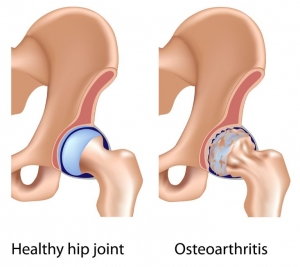THE HIP JOINT
 The hip joint is one of the largest joints of your body and is one of the most important joints utilized in walking and sitting and standing up.
The hip joint is one of the largest joints of your body and is one of the most important joints utilized in walking and sitting and standing up.
It is a joint between the Femur bone (thigh bone) and the Acetabulum of the pelvis and it supports the weight of the body and balances all the forces while walking, standing, squatting and running.
There are many ligaments which are attached around the hip joint which assist in acquiring a full range of motion for the hip joint.
HIP ARTHRITIS
If your hip joint is damaged by arthritis, movements shall start becoming painful. There will be pain while walking and running and towards the later stages there will also be hip pain while at rest.
The most common causes of hip arthritis are:
- Osteoarthritis – This is a degenerative wear and tear of the cushioning cartilage of the hip joint which fills the space between the two bones. This wear and tear leads to both the bones rubbing against each other and causing pain, stiffness and difficulty in movement.
- Avascular Necrosis – One of the most common causes which leads to secondary osteoarthritis. It occurs due to a compromised or reduced blood supply to the head of the femur which makes up one part of the hip joint. This leads to destruction of the head and leads to arthritis. Some of the common causes of avascular necrosis are previous history of trauma (fracture) to the femur, overuse of steroids, alcoholism or idiopathic.
- Rheumatoid Arthritis – It is an inflammatory condition of the lining of the hip joint, namely the synovium/joint capsule. It is believed to be caused by self-attacking antibodies produced by one’s own body. This condition starts much earlier in life commonly around the age of 20-30 years.
- Traumatic Arthritis – A condition which follows an injury to the joint most commonly following a fracture, hip dislocation or ligament injury.
Treatments Offered

